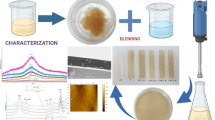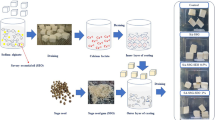Abstract
Edible coatings attract interest today as efficient and safe techniques for controlling the deterioration and extending the shelf-life of food products. In the present study, a layer-by-layer (LbL) electrostatic deposition of oppositely charged natural polysaccharides, a polyanion alginate and a polycation chitosan, was implemented for coating a model food: fresh-cut melon. The performance of the alginate–chitosan coating was compared with single-layer coatings and with non-coated control. The LbL coating was found to possess the beneficial properties of both ingredients, combining good adhesion to melon matrix of the inner alginate layer with antimicrobial activity of the outer chitosan layer, thereby reducing the bacteria, yeast, and fungi counts by 1–2 log CFU. The bilayer coating slowed down tissue texture degradation, so that after 14 days of storage only LbL samples maintained an appreciable firmness. An unexpected benefit of the LbL coating was that its enhanced gas-exchange properties exceeded those of both monolayer coatings and even of the non-coated control. As a result, the LbL coating prevented an increase in headspace CO2 and ethanol concentrations, which are the signs of hypoxic stress and off-flavor development observed in other samples, especially in alginate-coated melons. The phenomenon was presumably related to swelling behavior of the chitosan layer in the humid atmosphere of the fresh-cut melon package, giving the melon pieces an attractive succulent appearance. At the same time, the LbL coating resulted in somewhat increased produce weight loss due to the reduced surface water vapor resistance. The method is cheap, simple, and can improve the quality and safety of food products.





Similar content being viewed by others
References
Baldwin, E. A., Hagenmaier, R., & Bai, J. (2011). Edible coatings and films to improve food quality (2nd ed.). Boca Raton: CRC.
Baldwin, E. A., Burns, J. K., Kazokas, W., Brecht, J. K., Hagenmaier, R. D., Bender, R. J., et al. (1999). Effect of two edible coatings with different permeability characteristics on mango (Mangifera indica L.) ripening during storage. Postharvest Biology and Technology, 17(3), 215–226.
Ben-Yehoshua, S., Burg, S. P., & Young, R. (1985). Resistance of citrus fruit to mass transport of water vapor and other gases. Plant Physiology, 79(4), 1048–1053.
Brasil, I. M., Gomes, C., Puerta-Gomez, A., Castell-Perez, M. E., & Moreira, R. G. (2012). Polysaccharide-based multilayered antimicrobial edible coating enhances quality of fresh-cut papaya. LWT—Food Science and Technology, 47(1), 39–45.
Campos, C. A., Gerschenson, L. N., & Flores, S. K. (2011). Development of edible films and coatings with antimicrobial activity. Food and Bioprocess Technology, 4(6), 849–875.
Chen, J. (2002). Microbial enzymes associated with fresh-cut produce. In Lamikanra (Ed.), Fresh-cut fruits and vegetables: science, technology and market (pp. 249–266). Boca Raton: CRC.
Cissé, M., Kouakou, A. C., Montet, D., Loiseau, G., & Ducamp-Collin, M. N. (2013). Antimicrobial and physical properties of edible chitosan films enhanced by lactoperoxidase system. Food Hydrocolloids, 30(2), 576–580.
Cook, R. (2011). Trends in the marketing of fresh produce and fresh-cut products, University of California Davis, USA. Available at: ucce.ucdavis.edu/files/datastore/234-2115.pdf.
Corbo, M. R., Speranza, B., Campaniello, D., D’Amato, D., & Sinigaglia, M. (2010). Fresh-cut fruits preservation: current status and emerging technologies. In V. Méndez (Ed.), Current research technology and education topic in applied microbiology and microbial biotechnology (pp. 1143–1154). Badajoz, Spain: Formatex Research Center.
Decher, G. (1997). Fuzzy nanoassemblies toward layered polymeric multicomposites. Science, 277(5330), 1232–1237.
Dhall, R. K. (2013). Advances in edible coatings for fresh fruits and vegetables: a review. Critical Reviews in Food Science and Nutrition, 53(5), 435–450.
Dutta, P. K., Tripathi, S., Mehrotra, G. K., & Dutta, J. (2009). Perspectives for chitosan based antimicrobial films in food applications. Food Chemistry, 114(4), 1173–1182.
Falguera, V., Quintero, J. P., Jimenez, A., Munoz, J. A., & Ibarz, A. (2011). Edible films and coatings structures, active functions and trends in their use. Trends in Food Science and Technology, 22(6), 292–303.
Fallik, E., Shalom, Y., Alkalai-Tuvia, S., Larkov, O., Brandeis, E., & Ravid, U. (2005). External, internal and sensory traits in Galia-type melon treated with different waxes. Postharvest Biology and Technology, 36(1), 69–75.
Fernandez-Salguero, J., Gómez, R., & Carmona, M. A. (1993). Water activity in selected high-moisture foods. Journal of Food Composition and Analysis, 6(4), 364–369.
Ferrari, C. C., Sarantopoulos, C. I. G. L., Carmello-Guerreiro, S. M., & Hubinger, M. D. (2011). Effect of osmotic dehydration and pectin edible coatings on quality and shelf life of fresh-cut melon. Food and Bioprocess Technology, 6(1), 80–91.
Gomes, A. P., Mano, J. F., Queiroz, J. A., & Gouveia, I. C. (2012). Layer-by-layer deposition of antibacterial polyelectrolytes on cotton fibres. Journal of Polymers and the Environment, 20(4), 1084–1094.
Guilbert, S., Gontard, N., & Cuq, B. (1995). Technology and applications of edible protective films. Packaging Technology and Science, 8(6), 339–346.
Ham, J. M., & Heilman, J. L. (1991). Aerodynamic and surface resistances affecting energy transport in a sparse crop. Agricultural and Forest Meteorology, 53(4), 267–284.
Han, J. H., & Gennadios, A. (2005). Edible films and coatings. A review. In J. H. Han (Ed.), Innovations in food packaging, chapter 15 (pp. 239–262). Amsterdam: Elsevier Academic.
Hide, J. C. (1954). Observations on factors influencing the evaporation of soil moisture. Soil Science Society of America Journal, 18(3), 234–239.
Huber, K. C., & Embuscado, M. E. (2009). Edible films and coatings for food applications. New York: Springer.
Ito, A., Sato, M., & Anma, T. (1997). Permeability of CO2 through chitosan membrane swollen by water vapor in feed gas. Die Angewandte Makromolekulare Chemie, 248(1), 85–94.
Jacxsens, L., Devlieghere, F., Ragaert, P., Vanneste, E., & Debevere, J. (2003). Relation between microbiological quality, metabolite production and sensory quality of equilibrium modified atmosphere packaged fresh-cut produce. International Journal of Food Microbiology, 83(3), 263–280.
Kanti, P., Srigowri, K., Madhuri, J., Smitha, B., & Sridhar, S. (2004). Dehydration of ethanol through blend membranes of chitosan and sodium alginate by pervaporation. Separation and Purification Technology, 40(3), 259–266.
Krasaekoopt, W., & Mabumrung, J. (2008). Microbiological evaluation of edible coated fresh-cut cantaloupe. Kasetsart Journal (Natural Sciences), 42(3), 552–557.
Kurek, M., Ščetar, M., Voilley, A., Galić, K., & Debeaufort, F. (2012). Barrier properties of chitosan coated polyethylene. Journal of Membrane Science, 403–404, 162–168.
Lester, G. (1997). Melon (Cucumis melo L.) fruit nutritional quality and health functionality. HortTechnology, 7(3), 222–227.
Luna-Guzmán, I., & Barrett, D. M. (2000). Comparison of calcium chloride and calcium lactate effectiveness in maintaining shelf stability and quality of fresh-cut cantaloupes. Postharvest Biology and Technology, 19(1), 61–72.
Medeiros, B. G., de Pinheiro, S. A. C., Carneiro-da-Cunha, M. G., & Vicente, A. A. (2012). Development and characterization of a nanomultilayer coating of pectin and chitosan. Evaluation of its gas barrier properties and application on ‘Tommy Atkins’ mangoes. Journal of Food Engineering, 110(3), 457–464.
Miller, M. D., & Bruening, M. L. (2005). Correlation of the swelling and permeability of polyelectrolyte multilayer films. Chemistry of Materials, 17(21), 5375–5381.
Olivas, G. I., Mattinson, D. S., & Barbosa-Cánovas, G. V. (2007). Alginate coatings for preservation of minimally processed ‘Gala’ apples. Postharvest Biology and Technology, 45(1), 89–96.
Oms-Oliu, G., Soliva-Fortuny, R., & Martín-Belloso, O. (2008). Using polysaccharide-based edible coating to enhance quality and antioxidant properties of fresh-cut melon. LWT—Food Science and Technology, 41(10), 1862–1870.
Pizato, S., Cortez-Vega, W. R., de Souza, J. T. A., Prentice-Hernandez, C., & Borges, C. D. (2013). Effects of different edible coatings on physical, chemical and microbiological characteristics of minimally processed peaches (Prunus persica L. Batsch). Journal of Food Safety, 33(1), 30–39.
Raybaudi-Massilia, R. M., Mosquelda-Melgar, J., & Martín-Belloso, O. (2008). Edible alginate-based coating as carrier of antimicrobials to improve shelf-life and safety of fresh-cut melons. International Journal of Food Microbiology, 121(3), 313–327.
Rhoades, J., & Roller, S. (2000). Antimicrobial actions of degraded and native chitosan against spoilage organisms in laboratory media and foods. Applied and Environmental Microbiology, 66(1), 80–86.
Ribeiro, A. J., Silva, C., Ferreira, D., & Veiga, A. (2005). Chitosan-reinforced alginate microspheres obtained through the emulsification/internal gelation technique. European Journal of Pharmaceutical Sciences, 25(1), 31–40.
Rojas-Graü, M. A., Tapia, M. S., Rodríguez, F. J., Carmona, A. J., & Martín-Belloso, O. (2007). Alginate and gellan-based edible coatings as carriers of antibrowning agents applied on fresh-cut Fuji apples. Food Hydrocolloids, 21(1), 118–127.
Sangsuwan, J., Rattanapanone, N., & Rachtanapun, P. (2008). Effect of chitosan/methyl cellulose films on microbial and quality characteristics of fresh-cut cantaloupe and pineapple. Postharvest Biology and Technology, 49(3), 403–410.
SAS Institute (2003). JMP® 5.0.1 User’s Guide, SAS Institute, Inc., Cary NC, USA.
Serdyuk, I. N., Zaccai, N. R., & Zaccai, J. (2007). Methods in molecular biophysics: structure, dynamics, function. Cambridge: Cambridge University Press.
Simões, A. D. N., Ventrella, M. C., Moretti, C. L., Carnelossi, M. A., & Puschmann, R. (2010). Anatomical and physiological evidence of white blush on baby carrot surfaces. Postharvest Biology and Technology, 55(1), 45–52.
Sipahi, R. E., Castell-Perez, M. E., Moreira, R. G., Gomes, C., & Castillo, A. (2012). Improved multilayered antimicrobial alginate-based edible coating extends the shelf life of fresh-cut watermelon (Citrullus lanatus). LWT—Food Science and Technology, 47(1), 1–7.
Tapia, M. S., Rojas-Graü, M. A., Carmona, A., Rodriguez, F. J., Soliva-Fortuny, R., & Martin-Belloso, O. (2008). Use of alginate- and gellan-based coatings for improving barrier, texture and nutritional properties of fresh-cut papaya. Food Hydrocolloids, 22(8), 1493–1503.
Vázquez, E., Dewitt, D. M., Hammond, P. T., & Lynn, D. M. (2002). Construction of hydrolytically-degradable thin films via layer-by-layer deposition of degradable polyelectrolytes. Journal of the American Chemical Society, 124(47), 13992–13993.
Valencia-Chamorro, S. A., Palou, L., Delrío, M. A., & Pérez-Gago, M. B. (2011). Antimicrobial edible films and coatings for fresh and minimally processed fruits and vegetables. A review. Critical Reviews in Food Science and Nutrition, 51(9), 872–900.
Vargas, M., Chiralt, A., Albors, A., & González-Martínez, C. (2009). Effect of chitosan-based edible coatings applied by vacuum impregnation on quality preservation of fresh-cut carrot. Postharvest Biology and Technology, 51(2), 263–271.
Vargas, M., Pastor, C., Chiralt, A., McClements, D. J., & González-Martínez, C. (2008). Recent advances in edible coatings for fresh and minimally processed fruits. Critical Reviews in Food Science and Nutrition, 48(6), 496–511.
Acknowledgments
The research leading to these results has received funding from the Chief Scientist of the Israeli Ministry of Agriculture and Rural Development, Grant No. 421-0227-12 and European Union Seventh Framework Programme (FP7/2007/2013) under grant agreement n. 289719 (Project QUAFETY). We would like also thank Tatiana Yefremov for help in texture analysis. Contribution from the Agricultural Research Organization, The Volcani Center, Bet Dagan, Israel, No 646/13.
Author information
Authors and Affiliations
Corresponding author
Additional information
Sources of Support
1. Chief Scientist of the Israeli Ministry of Agriculture and Rural Development, Grant No. 421-0227-12.
2. European Union Seventh Framework Programme (FP7/2007/2013) under grant agreement n. 289719 (Project QUAFETY).
Rights and permissions
About this article
Cite this article
Poverenov, E., Danino, S., Horev, B. et al. Layer-by-Layer Electrostatic Deposition of Edible Coating on Fresh Cut Melon Model: Anticipated and Unexpected Effects of Alginate–Chitosan Combination. Food Bioprocess Technol 7, 1424–1432 (2014). https://doi.org/10.1007/s11947-013-1134-4
Received:
Accepted:
Published:
Issue Date:
DOI: https://doi.org/10.1007/s11947-013-1134-4




